Want your perfect workout program?
Take QuizPush Pull Legs Split: Best Routine To Maximize Mass & Strength

Written by Sam Coleman | Co-founder
Fact checked by Kirsten Yovino, CPT Brookbush Institute
 FACT CHECKED
FACT CHECKED
The purpose of a workout split is to strategically organize your workout volume (exercises, sets, reps) across the week for optimal, sustainable progress. It's about creating a well-rounded routine based on how many workout sessions you can consistently commit to each week.
If 3 workout days per week is what you decide, the Push Pull Legs (PPL) split is a proven, straightforward option. As the name suggests, it organizes workouts by push days, pull days, and leg days.
Keep in mind, while it's favorable for three days, it can be effectively modified to fit four, five, or even six training days per week.
In this guide, I provide a comprehensive three-day PPL routine aimed at muscle growth and strength gains, which should naturally improve body composition for those ranging from untrained to somewhat trained. Note that this routine assumes access to typical commercial gym equipment. I'll also outline how to adapt the PPL program to more frequent training or specific needs.

Push Pull Legs Explained
A 'Push Pull Legs' routine is organized into three workouts:
- Workout Session #1: Pushing Exercises
- Workout Session #2: Pulling Exercises
- Workout Session #3: Leg Exercises
If you train 3 days a week, the above could be scheduled Monday, Wednesday, Friday. If you increase your training sessions to four or five days, you can simply rotate back through the three workouts, starting where you left off at the beginning of the following week. You also have the flexibility of creating two groupings of PPL workouts, i.e. PPL A & PPL B, which you could rotate as such: Push A, Pull A, Legs A, Push B, Pull B, Legs, B, repeat.
Muscles Targeted in Push Workouts:
Push day targets the upper body muscles involved in pressing movements, primarily focusing on:
- Chest (Pectorals)
- Shoulders (Deltoids)
- Triceps
Additionally, pressing movements also engage the core, some upper back muscles, and even the legs to a certain extent.
Muscles Targeted in Pull Workouts:
Pull day targets upper body muscles involved in pulling movements, or your posterior chain. The primary focus will be your back and biceps.
- Latissimus Dorsi (Lats)
- Trapezius (Traps)
- Spinal Extensors
- Rhomboids
- Biceps
- Forearms
You’ll get a fair amount of core engagement with pulling exercises too. Moreover, direct work on the lower posterior chain (hamstrings, glutes, spinal erectors). It's common for lifters to program in deadlifts on pull days to separate it from leg day with squats.
Muscles Targeted in Leg Workouts:
Leg workouts will work the muscles of your entire lower body, including:
- Quadriceps
- Hamstrings
- Glutes
- Calfs
Keep in mind that 'push, pull and leg exercises' is not an exact science. There will be a degree of overlap between exercises and workouts.
Where to put abs in a PPL routine?
You have several options for ab-specific exercises:
- Put one or two exercises at the end of each workout
- End your leg day with some ab work (by nature of the PPL, leg day is often the shortest in duration, especially if deadlift is done on pull day)
- Do core training altogether separately (given the flexible nature of ab training, you can do this on a "rest day" or at a different time of the day at home).

Prepare to maximize your strength with our exclusive 13-week strength training program. 3, 4, and 5 day per week programming options.
The Best Push-Pull-Leg Routine for Muscle Mass & Strength
This routine involves 3 workouts that you will rotate through weekly over the course of 4, 8 or 12 weeks. Choose a set period of time (days/weeks/months) that you will stick to this routine. After, you can assess and decide to continue running the program or adjust. 8 or 12 weeks is recommended, but 4 weeks is a good minimum to see how things are going.
See below for scheduling options and training frequency modifications.
Push Day:
| Exercise | Sets | Reps | Intensity (% of max effort) | Rest |
|---|---|---|---|---|
| Push Press | 5 | 4 | 85-90% | 2 min |
| Bench Press | 4 | 5 | 85% | 2 min |
| Standing Shoulder Press | 4 | 6 | 80% | 2 min |
| Dips | 3 | 8 | 80% (add weight, if needed) | 1.5 min |
| Upright Rows | 3 | 8 | 80% | 1.5 min |
| Tricep Extensions | 3 | 12 | 75% (take last set to failure) | 1 min |
Pull Day:
| Exercise | Sets | Reps | Intensity (% of 1RM) | Rest |
|---|---|---|---|---|
| Dead Lifts | 5 | 4 | 85-90% | 2 min |
| Chin Ups | 4 | 6 | 80% max effort (add weight if needed) | 2 min |
| Bent-over Rows | 4 | 6 | 80% | 2 min |
| Kroc Rows | 3 | 15+ | Heavy (no true 1RM) | 1 min between arms |
| Face Pulls | 3 | 8 | 80% | 1.5 min |
| Bicep Curls | 3 | 12 | 75% (last set to failure) | 1 min |
Legs Day:
| Exercise | Sets | Reps | Intensity (% of 1RM) | Rest |
|---|---|---|---|---|
| Squat | 5 | 5 | 85% | 2 min |
| Barbell Hip Thrust | 4 | 6 | 85% | 2 min |
| Front Squat | 4 | 6 | 80% | 2 min |
| Leg Press | 3 | 8 | 80% | 1.5 min |
| Lunges | 3 | 10 steps | 75% | 1.5 min |
| Sumo Dumbbell Deadlift | 2 | 12 | 75% (last set to failure) | 1 min |
Feel free to adjust this push pull legs routine as needed (read on for more info). It is important to note, however, that the exercises in these workouts are listed in purposeful order, which you can think of as “Heavy—>Light”.
This means that the exercises at the top of each workout are more suitable for heavy weights while those at the bottom are more suitable for lighter weights. Do not immediately start with heavy weights if you are new to lifting. Start light.
*The 1RM% are an estimate and don’t need to be exact. Work with a number which you could knock out another 2-3 reps.
PPL Training Schedule & Frequency Options:
You have several options for both your training schedule and training frequency. I'll go over the various options that work best:
3x Per Week (Standard)
The key to a 3-day schedule is to separate the workout days as evenly as possible. This is better for recovery, training intensity, and overall keeping your metabolic engine going.
- M,W,F
- M,W,Sa
- T,F,Su
Don’t put too much thought into it. The only thing to remember: DO NOT train two days in a row unless you absolutely have to. That's my recommendation.
For more great training options, check out our 3 Day Workout Split Guide!
3-4x Per Week (Every Other Day)
Another option is to train every other day. This means some weeks you train four days, other weeks three. And if you miss a scheduled workout, it's ok.
Rather than basing things on a calendar week, the weeks are based on the completion of one full rotation of 'Push, Pull, Legs'. Whether that occurs at the beginning, middle or end of the calendar week is irrelevant. 8 weeks of training would be 8 full rotations of the three day routine, if doing a 3-4x training frequency like this.
As you can see, this would be 5 calendar weeks YET 6 "workout weeks":
- Push, Pull, Legs, Push (M,W,F,Su)
- Pull, Legs, Push (T,Th,Sa)
- Pull, Legs, Push, Pull (M,W,F,Su)
- Legs, Push, Pull (T,Th,Sa)
- Legs, Push, Pull, Legs (M,W,F,Su)
Many trainees have found this effective as it keeps rest days to only one day and allows them to mentally push hard on the training day. Further, some find the changing of the days an effective form of stimulus as your body/mind doesn't expect the same thing on the same day always.
4x Per Week
A 4-days-a-week push pull leg routine gives you a few different options. The first is to work out two days in a row twice weekly with a day or two of rest in between. The main benefit of this schedule is the two-day rest period. Some trainees like this as it gives them time to travel or the weekend off to spend time with family.
The other option is to train two days in a row, then two single days, all with one day of rest. This option has the benefit of being more consistent with only having one day of rest.
Even though it’s the same load, some trainees find taking two days of rest to be a little too much and get them out of their groove. Further, this schedule allows you to go really hard on the two single sessions as you know you get to rest the next day.
With these options in mind, different ways to program a 4-day push-pull-legs workout include:
- M,T,Th,F
- T,W,F,Sa
- M,T,Th,Sa
- M,W,Th,Sa
Check out our 4 Day Workout Split Guide for more great 4-day training options!
5x Per Week
You have one option for a 5-days-a-week push pull legs routine: to train three days in a row and then two days in a row, both with a single day of rest. This is the superior method as it allows for better recovery and more efficient workouts.
A 5-day push-pull-legs workout schedule looks like this:
- M,T,W,F,Sa
- M,T,Th,F,Sa
Some may say you could work out five days in a row and then two days of rest. Remember that the most effective way is to spread the workouts out as evenly as possible.
Working out five days in a row can be tough. Breaking it up into three days of training and two days of training is the better split. Still, if you want the entire weekend free, go for five days in a row.
Looking for more great 5-day routines? Check out our 5 Day Workout Split Guide and our 12 Week Powerbuilding Program with 5 Day Workout Split.
6x Per Week
The vast majority of people don’t need to train six days a week. It’s arguably no more effective than four or five days a week and can even be detrimental to your gains. Only advanced trainees should do this.
But if you fall into the advanced trainee bracket and want to give this a shot, there’s only one way to train six days a week. Six days of training with one day of rest. Choose wisely.
Check out our 6 Day Workout Split Guide for another great 6-day option!
Note: The routine laid out above can work for any of these training frequencies and schedules. However, if you opt for 4, 5 or 6 days per week, you may want to consider having two sets of PPL workouts (again, A & B workouts) to give yourself more exercise variety or spread things out more.

Prepare to maximize your gains with our exclusive 12-week hypertrophy training program. Choose between a 4 or 5 day training split and gain 2-12 pounds of muscle over 90 days...
Adjusting & Modifying The PPL Routine:
You can switch up the push pull legs plan to suit your training needs. Here are some common reasons and adjustments that can be made:
- If you don’t feel comfortable using very heavy weights, alter the rep range and intensity (increase reps, decrease weight load)
- If you prefer shorter more frequent workouts, increase training frequency and spread the workout volume out better, likely even adding volume in a way that's more manageable for you.
- If you want more leg or glute training, or any specific area, you can add an additional "accessory" day to the plan, or modify the split by adding exercises to the existing routine.
For the most part, adjustments on the fly or modifications to the program really fall into two main categories: Workout Volume & Exercise Selection.
1. Volume/Rep Schemes
When it comes to building muscle and strength, your workout volume - exercises, sets and reps - matters.
Altering the weights and other variables can create significantly different adaptation needs. Unless you are specifically training as a powerlifter or a bodybuilder, you should work out across the whole spectrum of reps.
Even professional lifters use the entire range as there is a distinct relationship between hypertrophy (muscle growth) and strength or power development. A bigger muscle can become a stronger muscle, and a stronger muscle can make a bigger muscle.
Below are some guidelines for the repetition spectrum:
- Power: 1-3 reps using 70-95% 1RM
- Strength: 4-6 reps using 80-90% 1RM
- Hypertrophy: 8-20 reps using 75-65% 1RM
- Endurance: 15+ using 50-65% 1RM
The vast majority of people will suffice, mainly working in the strength and hypertrophy range. The only real power exercise on this list is the push press. Other than that, a good rule of thumb is to have:
- 2-3 Exercises: 4-6 rep range
- 1-3 Exercises: 8 rep range
- 1-4 exercises: 12+ rep range
You can alter these a bit as you want, just be sure to have at least 1 exercise in each rep range.
Sets will range from 3-5 sets with 0:30-2:00 of rest in between.
- 4-5 Rep Range: Use 4-5 sets with 2:00 of rest
- 6 Rep Range: Use 4 sets with 2:00 of rest
- 8 Rep Range: Use 3 sets with 1:30-2:00 of rest
- 12+: Use 2-3 sets with :30-1:00 of rest
2. Exercise Selection
You also have the option to swap out exercises. If you are doing a PPL, you should follow the general rule of thumb: i.e. pushing exercises on push day. As long as you swap out exercises with relatively similar exercises, you aren't changing the essence of the program. For example, bent over barbell row can be swapped with t-bar row without concern. Both are compound lifts that allow for similarly heavy loads and engage similar muscle groups.
That's the best way to go about tailoring a program like the PPL to suit you. You may want to alter this due to temporary or more permanent limitations.
Besides that, you can also add some accessory work at the end of days you feel up for it. It can be anything, just make sure that you aren't stressing a muscle you'll need to use soon!
You can alter any of these variables and see good results as long as you use progressive overload!
More on exercise selection & swaps below..
What to do after running the PPL routine for a set number of weeks?
Four strategies for continuing to progress your push-pull-legs workout program are:
1. Swap out exercises: If you find that your growth has become stagnant after a few months running the Push Pull Legs routine, all you need to do is swap out similar movements. The only key is that they should have similar biomechanics. Examples are:
- Bench Press—> Incline Bench Press or Dumbbell Bench Press
- Deadlifts—> Trap Bar Deadlifts or Deficit Deadlifts
- Chin-ups—> Pull-ups or Lat Pull-Down
We'll get into more information on exercises shortly, giving you an even better idea of substitutions you can make.
2. Change the order of exercises: Instead of swapping out exercises, just swap the order. For example, instead of doing a push press first on the pushing day, train bench press first.
3. Alter the rep scheme you are using: This is called periodization and consists of blocks where you change from training a movement in the power, strength, and hypertrophy range.
4. REST! Take a de-load week every once in a while or take off completely and just train core or HIIT.

Exercise Selection
The majority of your exercises should consist of compound movements, which are effective for stimulating hypertrophy, building strength, and hitting multiple major muscle groups. As you train multiple muscle groups simultaneously, especially when compared to isolation movements, it will cut down on the length of your workouts.
You can still work in some isolation exercises for any muscle groups that you may be targeting for more growth.
Keep in mind that every compound lift doesn’t need to be a “big” compound movement. For example, upright rows and face pulls (you will do both) are compound movements but don’t use as much weight or muscle mass as a deadlift or bench press.
Let's take a look at the different movement patterns, along with some exercise examples, so you can better understand the best types of moves for your PPL program.
The six main movement patterns to include in your Push Pull Legs workout are:
- Vertical Pushing: Shoulder Press, Dumbbell Press
- Horizontal Pushing: Bench Press, Push-Ups
- Vertical Pulling: Chin-Up Pull-Up, Pull Downs (e.g. Lat Pull-Down, Close-Grip Pull-Down)
- Horizontal Pulling: Bent-Over Row, Dumbbell Rows
- Hip Hinge: Conventional Deadlift, Hip Thrusts, Romanian Deadlift
- Squat/Lunge: Back Squat, Front Squat, Lunge
Many of these exercises are done with a barbell or dumbbells, but if you are a beginner, want to train at home, or like the idea of minimal equipment, you can easily perform these movements with resistance bands.
Top Pushing Exercises:
- Push Press
- Bench Press
- Overhead Shoulder Press
- Dumbbell Incline Press
- Dips
- Upright Row
- Cable Fly
- Skull Crushers
- Tricep Pressdowns
1. Push Press:
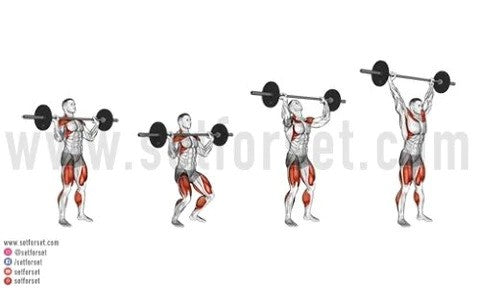
The push press is the only power exercise on this entire list. That’s because a large percentage of trains have zero power exercise in their regimen and the push press is the easiest to perform.
Plus, addressing the issue of Push Pull Legs being bias towards the upper body, you will have to generate explosiveness with hip extension that will rely on the glutes. Being a power exercise, you will work just about every muscle in the body while concentrating on hip extension, the shoulders, and triceps.
2. Bench Press:
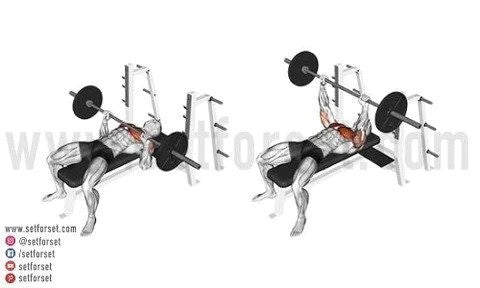
The bench press is the most popular pressing exercise there is. And for a good reason. Trainees can use a significant amount of weight to overload the pec, shoulders, and triceps.
3. Overhead Shoulder Press:

While the bench press is the modern-day king of pressing, the overhead shoulder press used to reign supreme, and for many, it still does. This is a move that requires mobility and can be harder to progress on it, but that's all the more reason to include it in your routine.
Overhead is going to strengthen your shoulders and upper back while also activating your entire core for support. Plus, it will require you to fix the mobility and stability of your shoulders.
Pro-tip: On light days, perform a shrug at the top of the movement for some serious upper-back track training.
4. Dumbbell Incline Press:
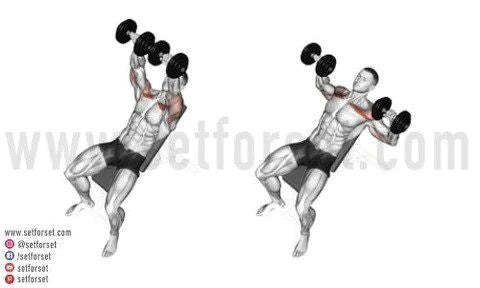
The incline dumbbell press is an extremely challenging exercise that targets your upper chest. Also, because the dumbbells allow horizontal shoulder abduction (moving your arm toward the center of your body), you will get more activation in the pectoral muscles as a whole.
Set the bench somewhere between a 30-40 degree incline
5. Dips:
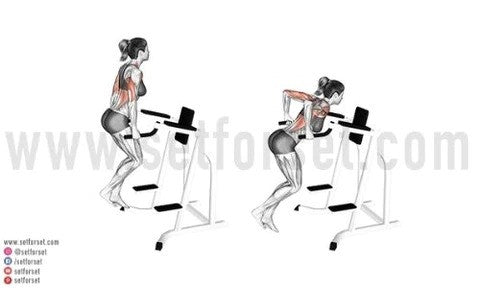
A misconception exists that the bench press is the best movement for the chest. It’s not. The dip is. The bench is still a great movement for strength and power development, but it doesn’t it the chest as much as people think. There’s an adage that goes around the old-school gym guys.
“Bench builds the tri’s. Dips build the chest”
If you want a huge chest, you need to do dips. They are the best pushing bodyweight exercise there is, and their movement pattern can’t be replicated.
6. Upright Row:
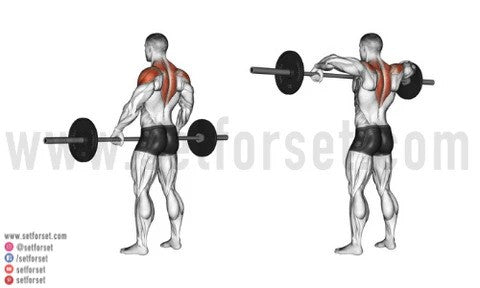
As mentioned above, the upright row is a movement that falls somewhere between a push and a pull exercise due to the muscles it works. However, it’s good to work this in on your pushing day.
The upright row will primarily work your delta and upper back while also hitting the biceps some.
7. Cable Fly:
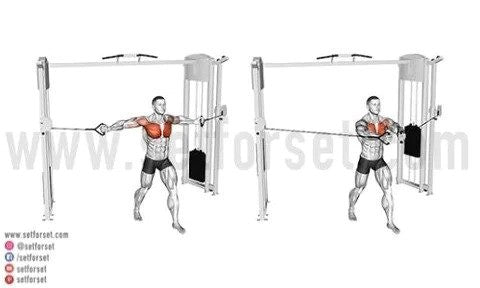
The chest fly is a great movement for the chest, shoulders, and arms. It is particularly effective for the chest as you can really squeeze and create tension. Over time, you can build a really defined chest with the chest fly. It can be done with a cable machine, dumbbells, or a pec deck.
Do all three to switch things up. Moreover, try to hit the fly from different angles by adjusting the cable pulley level or doing incline, flat, and decline db chest fly.
8. Skull Crushers:
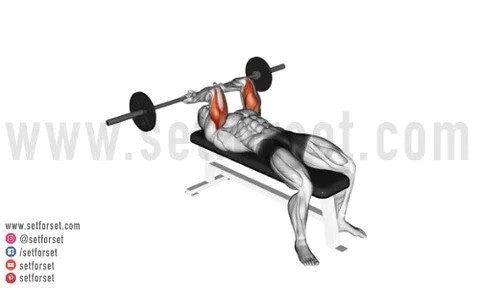
An old-school classic and perhaps the best tricep isolation exercises there is. Use an EZ-curl bar as it will be much more comfortable for skull crushers.
9. Tricep Pressdowns:
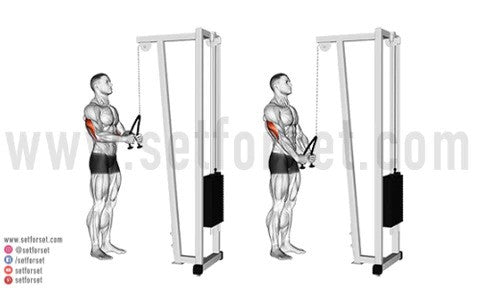
Tricep pressdowns are a great exercise to target the triceps. Plus, there are a ton of varieties that you can do with this one move. Rope, reverse-grip straight bar, prone grip straight bar, Y-handle...the best option is to just do all of them.
Check out our Pushing Exercises Guide to learn more about pushing movements.
Top Pulling Exercises:
- Deadlift
- Chin Ups
- Bent-Over Barbell Row
- Kroc Rows
- Close-Grip Seated Row
- Frontal Shrug
- Face Pull
- Bicep Curl With Cable Machine
Let's learn how to perform each.
1. Deadlift:

Being the king of barbell movements, the deadlift reigns over them all. While used for lower-body exercises, the deadlift is genuinely a full body workout. Using the deadlift on your pulling day is a great way to run this program as it allows you to essentially hit your legs on two days of a Push Pull Legs split. It also allows you to concentrate on it separately from the squat.
The deadlift is going to primarily train the hamstrings, glutes, and spinal erectors. However, the quads are also used extensively in this movement to push into the ground (which is also a great cue!) along with the traps and lats to keep the upper back from solid.
If you don't want to do conventional deadlifts, there are several deadlift alternatives that are almost as good in terms of building size and strength.
2. Chin-ups:
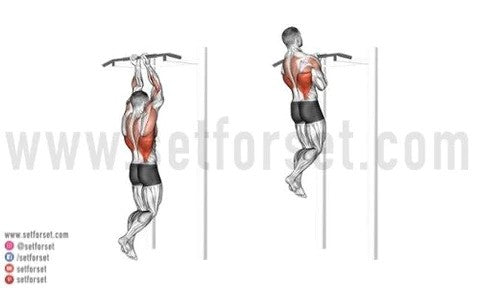
Not only are these the king of bodyweight pulling exercises, but they are the king of pulling exercises. Period.
Chin-ups are going to work literally every back in your muscle PLUS your biceps as you use an underhand grip. Studies show they will even activate more muscles than the lat-pulldown, making them the superior back exercise1. On top of that, you will also get a killer core workout.
Wondering what the difference between pull ups and chin ups are? Head to our article comparing Pull Ups vs Chin Ups to learn more.
3. Bent-Over Barbell Row:
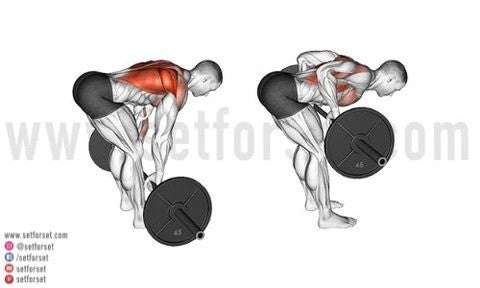
The bent-over barbell row is going to destroy your back in the lateral plane (horizontal pulling). Like the chin-up, it will train your entire back but with different biomechanics, like giving your back a whole new stimulus.
Since you are doing this movement bent-over, it is also a great movement to train your posterior chain (hamstrings, glutes, spinal erectors) with an insane isometric hold. These muscles will fire like mad to give you a solid base to pull from.
Bent-over barbell rows work well, heavy or light. Traditionally done with an overhand grip, you can also easily switch to an underhand grip creating a new stimulus with essentially the same exercise.
4. Kroc Rows (For Intermediate and Advanced):
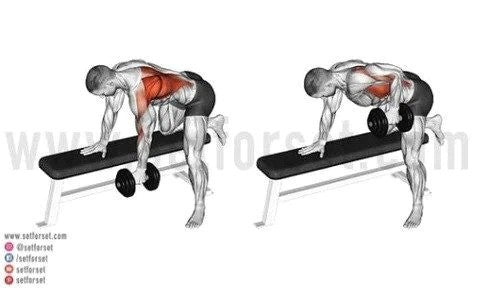
If you are a beginner, stick to the traditional dumbbell row to focus on the dumbbell row’s biomechanics. However, once you have been training for a while, you might want to try these.
Kroc rows are similar to the dumbbell row, but they use a lot more weight and a lot more body momentum. Essentially, a Kroc row consists of using a very heavy dumbbell but doing a lot of reps. Think of a weight that you can do, maybe four or five good reps with a clean dumbbell row but knocking out 15+.
To do this, you use a very explosive motion at the bottom of the rep and a little body momentum. Don’t worry about “concentrating on the contraction”. The weight used will be more than enough to overload the muscles as you will be knocking out a ton of reps.
Note: Although this is done with high reps, treat it like a heavy exercise.
5. Close-Grip Seated Row:
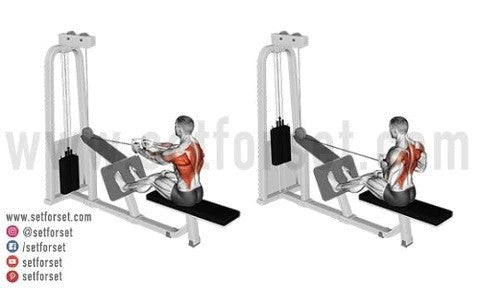
Time to take a seat and really focus on hitting the back. The close-grip seated row is a great exercise to use with lighter weight and high reps (Now you can focus on your mind-muscle contraction!). While the above exercises are focused on strength development, use this exercise to concentrate on hypertrophy.
"Close-grip” is listed as its biomechanics are substantially different from the bent-over barbell row. However, it’s a good idea to use various grips with this movement: Wide-grip, neutral grip, even a rope attachment.
Everything is virtually the same for the set-up. Still, the difference in grip will hit the back slightly different while also adding enough variety to keep this exercise exciting.
For some more great row variations, check out our article on the best Seated Cable Row Alternatives,
6. Frontal Shrug:
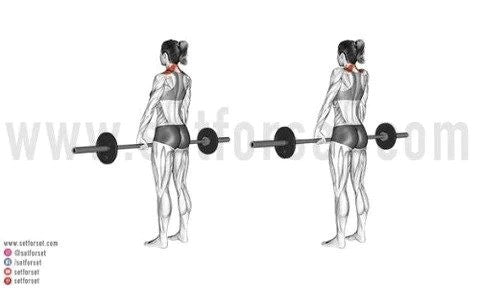
When you think of traps, Olympic lifters are king. And what do all of these movements start with? A frontal shrug.
Nothing will make you look more swole than a nice set of upper traps. To really make them grow, you need some direct work, and that's where the frontal shrug comes in. Studies have shown that this variation, compared to other shrug variations, is the most effective in activating the most amount of muscle fibers2.
A frontal shrug is done by holding your hands in front of your body with a prone grip. While this could be done with dumbbells, the best bet is to just use a barbell.
Because the range of motion is naturally small, be sure to get a nice long pause at the top. A good practice is to use heavy weight with low reps but a long pause at the top (3+ seconds). This allows sufficient time under tension while using heavy-weight.
7. Face Pull:
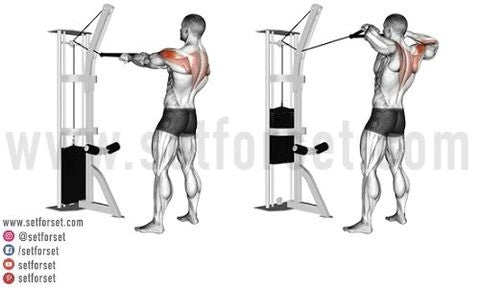
Face pulls are the ultimate accessory pulling movement and play an important role in a good push pull legs routine. This exercise is going to significantly increase the strength of your traps, rhomboids, and anterior delta. Collectively, this will increase your scapula control, improve your shoulder health, and fix your posture.
Want some more great options? Check out these Face Pull Alternatives.
8. Bicep Curl With Cable Machine:

It’s always a good idea to have a pulling exercise to specifically train elbow flexion. Besides building a bulging bicep, bicep curls will strengthen the elbow joint’s tendons and ligaments, helping to mitigate future injury as the elbow is a common location for an overuse injury.
The cable machine is a great option to use for bicep curls as they are easier to swap out attachments or weights if you want to throw in some compound sets. Like the tricep extension, we’re not going to suggest one type; just consistently swap variations around.
- Rope Attachment
- Hammer Curl
- EZ Handle
- Reverse Grip
Looking for even more information on pulling movements. Check out our Pulling Exercises Guide!
Top Leg Exercises:
- Back Squat
- Front Squat
- Barbell Hip Thrust
- Leg Press
- Lunges
- Sumo Deadlifts
1. Back Squat:
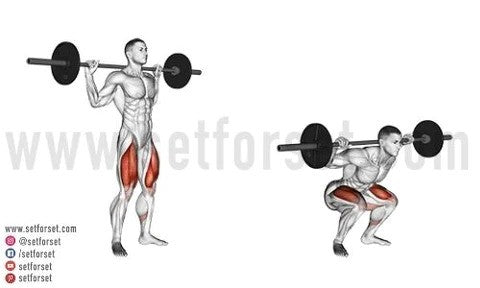
The back squat is a must-have in your training routine. They are the greatest exercise to create pure size and strength in the entire lower body.
Plus, you will get an insane core workout. Squats will make your quads, glutes, and hamstrings blow up.
2. Front Squat:
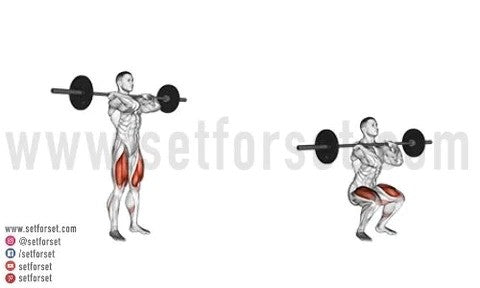
The unpopular, but possibly more effective brother of the back squat, is the front squat. In actuality, front squats are the preferred movement by many professional athletes’ coaches as it has better transfer to athletic movements. It’s also going to drastically increase your mobility and core.
The front squat differs from the back squat as the bar is set in the front of the body. This little change causes a massive difference in the biomechanics of the movement. As the lifter descends, he must keep an excessively upright torso to keep the bar from falling.
This means little hip flexion and more knee flexion, resulting in a much larger load placed on the quadriceps. If I could only do two lower body exercises, it would be the front squat for the anterior muscles and the deadlift for the posterior muscles.
You can read more about the differences between the two squats in our article comparing the Front Squat vs Back Squat.
3. Barbell Hip Thrust:
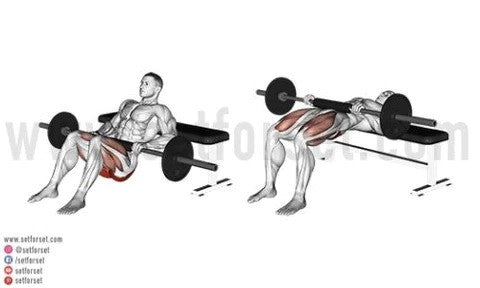
The barbell hip thrust is the best exercise to train the glutes. Not only will it create a powerful butt and hamstrings, but it’s also going to have an incredible transfer of performance to the deadlift and back squat.
Just be warned: Start light! Trainees unaccustomed to this exercise are not used to the amount of activation they get in their glutes and hamstrings. This can leave you incredibly sore if you do too much too soon.
4. Leg Press:
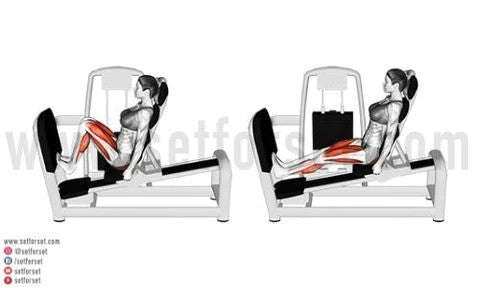
The leg press is the only machine on this list. It is an extremely effective way to train your entire lower body while taking strain off of your lower back, allowing you to get more volume in without getting injured.
Also, you can alter the muscle activation by changing the seat angle and leg placement. Neither is better or worse than the other so play around with different variations.
Check out our article on Leg Press Alternatives for more moves that work the same muscles in the same ways.
5. Lunges:
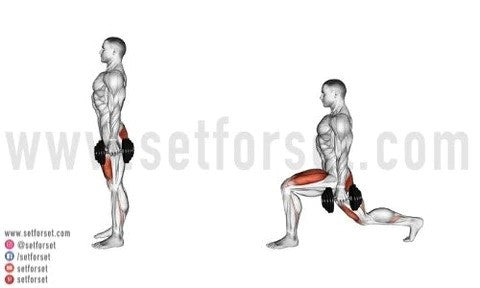
Lunges are tough. Real tough. Many trainees find this exercise to be harder than squats or deadlifts. That also means they are very effective. While lunges are not a true unilateral exercise, as you use both legs to perform the movement (known as bilateral), the emphasis is placed on the forward leg.
Lunges will kill your quads, glutes, hamstrings, and calf muscles and significantly increase your balance and coordination (they’re not as easy to perform as they look!).
One of the great things about lunges is that they are incredibly effective with just body weight or holding dumbbells to increase the load. Lunges are generally done with at least 10 reps (5 per leg) as they are not very suitable for heavy loads. Many great lifters' common practice is to only use body weight with lunges and perform very high volumes with them - as in 100+ steps.
Looking for similar moves to target the same muscles? Check out these Lunge Alternatives!
6. Dumbbell Sumo Deadlifts:

Dumbbell and kettlebell sumo deadlifts are an amazingly effective yet underutilized exercise. Due to the higher amount of knee flexion and wider stance in a sumo deadlift, you will get more activation in the quadriceps and that pesky area for many, the inner thigh; otherwise known as the hip adductors.
Because the mobility required for the sumo deadlift is much more difficult for people, using a single dumbbell or kettlebell is a much better option for universal use. Use higher reps for this one, which gives your training some stimuli variety.
Alternative Exercises
Here are more exercises that we recommend for a PPL routine. You can swap out any of the exercises in the routine for a comparable exercise found in the table below:
|
Alternative Pushing Day Exercises |
Alternative Pulling Day Exercises |
Alternative Leg Day Exercises |
|
Dumbbell Press |
T-Bar Row |
Trap Bar Deadlift |
|
Close-Grip Bench Press |
Rack Pulls |
Leg Press |
|
Push-ups |
Landmine Rows |
Romanian Deadlift |
|
Landmine Presses |
Pull-Ups |
Bulgarian Split Squat |
|
Seated Shoulder Press or Dumbbell Press |
Straight Arm Lat Pulldown |
Calf Raises |
|
Arnold Press |
Lat Pull Down |
Leg Curl |
|
Overhead Tricep Extensions |
Standing Single Arm Row (with Cable) |
Leg Extension |
The Top Benefits of Using a Push Pull Leg Split
Using a push-pull-leg workout routine for your training program offers a ton of great benefits. Here are a few of them.
- Easy To Plan: Using a PPL scheme makes it very easy to plan out your program, helping you know exactly what movements you need to train that day.
- It’s Effective: Push Pull Legs has been used by thousands of trainees of all levels with great success over the years. As long as you use the principle of progressive overload, PPL will get you the results you are looking for, whether that's gaining muscle and strength, losing fat, or all of the above.
- Train Every Body Part: Using a Push Pull Legs split routine will guarantee you train every muscle group efficiently.
- Can Add Variety: If you train four or five times a week, your weekly plan will never look the same, which can keep things interesting. Something as minor as starting the week off with a different plan can go a very long way in keeping things exciting.
- Easy To Alter And Personalize: Using a Push Pull Legs routine is very easy to alter for your needs. Try adding training days during the week to increase your volume. Or, use PPL as their base and then make some adjustments or add special training days to suit your needs.
Push Pull Legs….Go!
We just covered everything you need to know about this amazingly effective push-pull-legs workout split. Use this push-pull-legs routine as your base while adjusting the plan to fit your needs and training level.
Versatility, adaptability, and awesome results - that's what we like to see in a great workout split! As long as you maintain the fundamental ideas, a PPL workout plan will work for you.
Interested in more great workout routines? Check out our free database of workouts & plans!
OR take our quick workout quiz to find the perfect program in under a minute.

References:
- Farias D de A, Willardson JM, Paz GA, Bezerra E de S, Miranda H. Maximal Strength Performance and Muscle Activation for the Bench Press and Triceps Extension Exercises Adopting Dumbbell, Barbell, and Machine Modalities Over Multiple Sets. Journal of Strength and Conditioning Research. 2017;31(7):1879-1887. doi:https://doi.org/10.1519/jsc.0000000000001651
-
Lee JH, Cynn HS, Choi WJ, Jeong HJ, Yoon TL. Various shrug exercises can change scapular kinematics and scapular rotator muscle activities in subjects with scapular downward rotation syndrome. Human Movement Science. 2016;45:119-129. doi:https://doi.org/10.1016/j.humov.2015.11.016

Also in Blog
Recent Articles
-
Calories In, Calories Out Myth: Fact or Fiction?April 08, 2025
-
Cardio Or Strength Training: What's Better For Weight Loss?April 03, 2025
Must Reads
-
Mr Olympia 2024: What to Expect This Year (Oct. 10-13, 2024)September 11, 2024
-
What Can Walking For 1 Hour Everyday Do For You? My ExperienceFebruary 28, 2024
-
The Ultimate "Bro Split" Workout Plan (Backed By Science)August 05, 2023
- Blog
- Exercises
- Workouts
- Meal Plans
- SFS Programs
- Apparel
- About Us
- FAQ
- Shipping
- Warranty
- Contact Us
- Terms & Conditions
- Privacy Policy
- Affiliates
- SFS UGC Policy
- SFS MBG Policy
- Disclosures
- Legal Disclaimer
Sign up to get the latest on sales, new releases and more…
© 2025
SET FOR SET.
Powered by Shopify
















Sam Coleman
Author